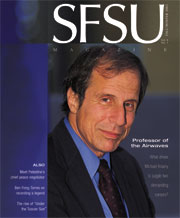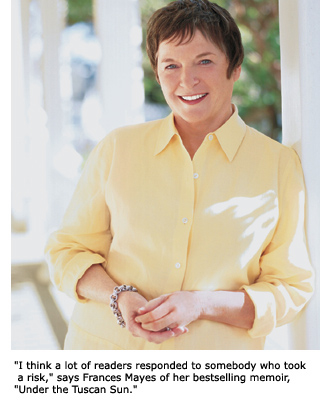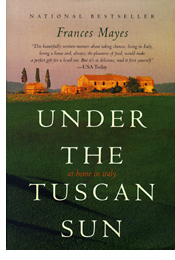 |
| |||
It Takes a Villa In 1990 Frances Mayes, then a professor at SFSU, sank her savings into a dilapidated 300-year-old villa in Tuscany. She and her future husband, Ed, enlisted the help of workers who lived nearby to restore the house to its former glory. Mayes chronicled their scrubbing, digging, cooking, shopping, planting, and painting in "Under the Tuscan Sun," a 1996 memoir which enjoyed an initial 162-week stay on The New York Times bestseller list. The Hollywood version, which hit theaters in September, takes a few liberties with the book, but Mayes says the message is the same, that life in Italy is indeed la dolce vita. Hours before a phone interview from her home in Cortona, Italy, three weeks after the release of the Touchstone Pictures movie, "Under the Tuscan Sun," Mayes (M.A., '75) learned that her memoir was back at #1 on the Times' nonfiction bestseller list. "When I found out this morning," she said, "I felt like throwing open the window and going woo-hoo, woo-hoo!" Lately, Mayes has had plenty to woo-hoo about. Her first novel, "Swan," a story inspired by memories of her hometown of Fitzgerald, Ga., hit bookstores during the movie shoot. There are two new books in the works, and -- move over, Martha Stewart -- in the fall Mayes launched her own furniture line with Drexel Heritage, a collection called "At Home in Tuscany" that includes reproductions of antiques Mayes has collected across Italy. "Usually you write a book, there's a buzz, and then things settle down," Mayes says. "'Under the Tuscan Sun' seems to have legs and a will of its own. It keeps leading me in different directions." Hollywood was a surprising destination for what Mayes herself describes as "a quiet book." As a creative writing professor at SFSU, she had six books of poetry published before she wrote "Under the Tuscan Sun." Not surprisingly, the memoir is rife with metaphor, literary allusion and internal rhyme. It's a tale of an American exploring the landscape and language of Italy -- and the food. There are two chapters devoted entirely to Mayes' recipes for Italian delicacies such as winter pears in vino nobile. The writing is lovely, but, as movie producers told Mayes for many years, there's no dramatic storyline. "Under the Tuscan Sun," the movie, some of these producers insisted, needed car crashes, mystery and intrigue, perhaps a ghost who could haunt the villa. "Everyone I talked to had really bad ideas," Mayes says. A chance encounter would bring Mayes an idea she considered a very good one. In 1998 movie producer Tom Sternberg walked into a Pienza, Tuscany, wine shop where Mayes and her husband were admiring wine glasses. Sternberg had just finished a day on the set of "The Talented Mr. Ripley." "We started chatting and told Tom we lived in Tuscany," Mayes recalls. "He said he'd read a wonderful book about someone who restored a home there." Sternberg was excited to learn he was speaking with the author herself. A short time later, he reread her memoir and asked screenwriter Audrey Wells ("The Truth About Cats and Dogs," "Guinevere") to think about a screenplay. "Her view," Sternberg says, "was that âUnder the Tuscan Sun' should be a lush, classical romantic comedy whose point is that if you stop looking for love, love will find you." San Francisco State Like the movie character, SFSU Professor Toni Mirosevich, a real-life former student, has nothing but praise for Mayes' teaching. "Frances could look at people's work and be supportive and also use her eagle eye as a poet to see what's working and what's not working in a piece. She inspired so many to continue with their art and for me, to continue with my teaching," she says. Like Mirosevich, Mayes decided to teach at her alma mater, staying on after her graduation in 1975. Over the years, as Mayes took on additional duties as department chair and director of SFSU's Poetry Center, she found her free time for writing slowly slipping away. "In my working life in California, it seemed I was always behind," Mayes says. "There was a sense of cramped time. I got caught up in the American way of being obsessed with work." The demanding workload coupled with an end to her first marriage would lead Mayes to Italy, where she found she "existed comfortably in time." She and her new beau, Ed Kleinschmidt, a poet and professor There were many to choose from but Mayes only had eyes for an apricot-colored house named Bramasole. After going through a dark time, it seemed appropriate to take up residence in a place whose name means "something that yearns for the sun." Restoring a house -- let alone in another country -- was uncharted territory for Mayes. "I was afraid I might be crazy," she says. "I knew it was a risk. It was the sense of risk that was appealing. I wanted to do something I didn't know how to do." Bramasole's crumbling walls, malfunctioning toilets and resident scorpions didn't kill the romance. She and Ed were married in 1998. Three years later, the success of "Under the Tuscan Sun" enabled Mayes to retire and focus on her writing full-time. The College of Humanities lost a terrific faculty member, says Stephen Arkin, chair of the English Department, "but it has been fun to see where she's gone. Frances is a gifted poet, a marvelous teacher; she's good at everything she's ever tried." From book to the big screen When the final draft was accidentally delivered to a grocery store in Cortona, Ed jumped into his truck They approved of the script as well as Diane Lane, the actress who would play Mayes. Fresh off her performance in the steamy "Unfaithful," Lane didn't have to cool off entirely to play Mayes. The movie version of "Under the Tuscan Sun," unlike the book, is light on remodeling and heavy on romance. Diane Lane's Mayes goes to Tuscany alone. Ed doesn't enter until the final scene. In the meantime, the SFSU professor gets involved with a handsome Italian man -- something the real Frances Mayes confirms did not actually happen. "No, unfortunately. But I'd love for my relatives back in Fitzgerald to think I had an affair with a hot Italian guy," she says with hearty laugh. Mayes considers the film a classic romantic comedy. "It's one of those movies where you get the sense that things are going to turn out alright in the end," she says. (In the movie, Frances doesn't lose her faith in romance: she survives her divorce as well as the unfortunate news that her new Italian man, the one who told her "You have beautiful eyes, Francesca. I wish that I could swim inside them," has been, well, trying to swim in someone else's eyes.) Ebert and Roper gave the movie two thumbs up. Some reviewers couldn't get past the disparities between the book and the movie. "Some critics liked it. Some didn't," Mayes responds in her typical Southern straight talk. "If there were no difference in opinion, there would be no horse races." She says the movie captured the spirit of her book, that "risks are worth taking -- you can transform your life." Inside Bramasole Mayes doesn't feel her privacy has been invaded. "Not bothered by anyone," she insists. "The people who come are not the bad type of tourists -- the ones who drop their ice cream wrappers on the ground and wear short shorts." Moviegoers clamoring for a peek at the villa will be disappointed. The house on screen is an imposter. "Bramasole is much more beautiful than the house in the movie," Professor Mirosevich insists. She's kept in touch with Mayes over the years and has visited the Tuscan villa on more than one occasion. "Frances is incredibly welcoming," she says. "There's a terrace with linden trees -- you sit underneath them and eat tomatoes from her garden, have a glass of wine ⦠it's heaven." "Not a heaven I know," she adds with a laugh, excusing herself to attend to more than a dozen students congregating at her office door. An American in Tuscany "As a writer it's pretty dangerous to cut yourself off from your own country and isolate yourself from your own language," she says. "Language keeps changing." The woman who risked a new life in a new country continues to head into new writing territory. She's In the closing scene of "Under the Tuscan Sun," the movie, Diane Lane beams as she assesses her new life in Tuscany. After heartbreak, she realizes she has a lot to look forward to. She has a beautiful house and good friends. A new man appears and it looks like this one might turn out to be the right guy. We're left to think that all is right in the life of Frances Mayes. By all observations, the real-life writer is indeed living the sweet life in Tuscany. "I'm enormously lucky," she says, "I have a great family and I'm grateful to the public. I could write about Italy forever -- it's always so new." What more could Mayes want? A little more of that Tuscan time that first called her to Bramasole. With the publicity for the movie and her work with Drexel Heritage, Mayes once again is finding the moments for her writing few and far between. "I'd like to get back to that quiet where I can feel connected to writing -- I'm missing that," she says. Mayes says the house was in far worse shape than Bramasole, but she and Ed have learned one thing from their first go at remodeling: "This time," she says, "we're having other people do all the work." -- Adrianne Bee More information: The Frances File
| ||||










